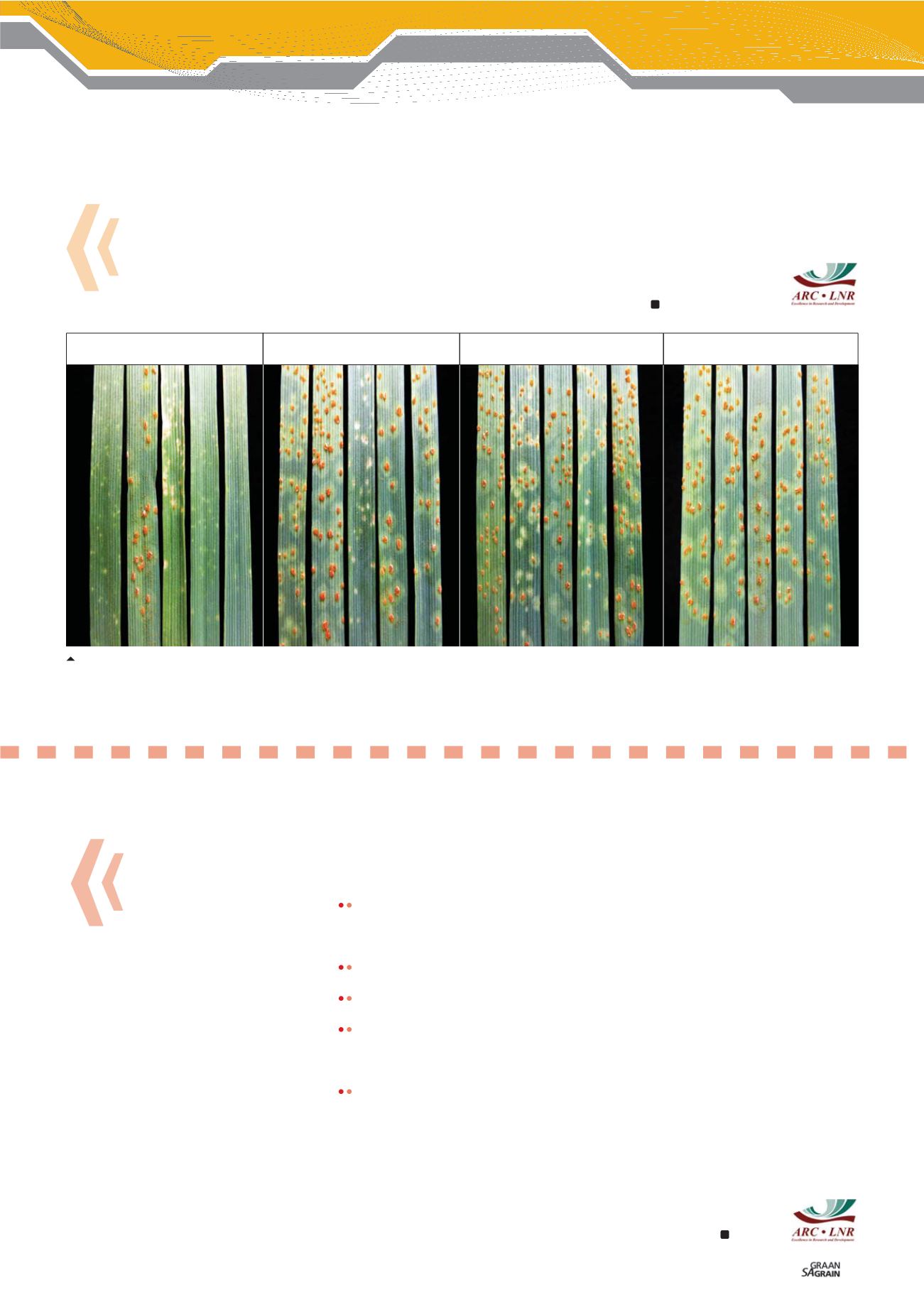

79
September 2017
Observation of susceptibility on a previously resistant cultivar is an
indication that the new races have probably caused the infection and
that the specific cultivar has lost its leaf rust resistance.
In this case, timeous fungicide application may be required to pre-
vent possible further outbreaks and consequent economic loss. Rac-
es 3SA10, 3SA38 and UVPt26 bring the number of new leaf rust races
identified over the past seven years to seven, indicating continued
variability of rusts in South Africa and stressing the need for regular
rust monitoring to timeously identify and control new races. There
were no new stem rust or stripe rust races detected in
2016. Therefore, previously known resistant genes and
cultivars are expected to remain effective against the
existing races of the two rusts.
1: Comparative photos indicating infection of an existing leaf rust race 3SA145 and three new leaf rust races 3SA10, 3SA38 and UVPt26 on seedling
leaves of wheat lines containing the leaf rust resistance genes (left to right):
Lr24
,
Lr26
, and
Lr20
as well as two wheat cultivars PAN 3515 and SST 087.
Production of large brown pustules on the infected leaves indicate susceptibility and the white flecks with or without smaller pustules indicate a resist-
ant or intermediate reaction. The existing leaf rust race 3SA145 is only virulent on
Lr2
6. 3SA10 is virulent on
Lr24
,
Lr26
, PAN 3515 and SST 087, 3SA38 on
Lr24
,
Lr20
and SST 087 and UVPt
26
are virulent on all five entries.
Photo: Prof Zakkie Pretorius
3SA145
3SA10
3SA38
UVPt26
Wheat rusts continue to evolve
diclofop (Hoelon, Ravenger, Trigras), fluazi-
fop (Fluazifop-P-butyl 125, Volley, Fusilade
Forte), haloxyfop (Gallant Super, Grassclear,
Scorp), butroxydim (not in South Africa),
sethoxydim (Nabu), tralkoxydim (Trinity EC)
and pinoxaden (Axial), should be avoided.
The use of any of the listed herbicides will
result in reduced weed control and may re-
sult in homozygous resistant weed plants.
It is evident that the most prevalent mu-
tations in the wild oats biotypes were
ALS mutations 205 and 574 (rendering all
Group B herbicides useless) and ACCase
mutations 2027 and 2078 (indicating limited
herbicide choice within the ‘fops’, ‘dims’
and ‘den’ herbicides) (Graph 1 and Graph 2).
How to get your grass
weeds tested for
resistance?
Producers are welcome to send grass
weed seedlings or seeds to ARC-Small
Grain, Bethlehem at ARC-Small Grain, S191
Blydskap Road, Bethlehem, 9700.
Remember:
Seedlings must be kept moist (prefer-
ably in Ziplock bags) and must prefer-
ably be couriered, as it will ensure that
fresh seedlings arrive in Bethlehem.
Indicate the GPS-co-ordinates where
plant or seed samples were taken.
Seeds must be stored in brown paper
bags to prevent them from rotting.
The number of seeds/seedlings must be
a large enough bulk representative field
sample to enable an accurate screening
process.
Make sure that a number of samples
from the problematic field are sent in.
One plant only will not be adequately
representative of the problematic field.
All samples received are screened in
replicates of four to six times.
Summary
Target-site resistance does occur in wild
oats samples received from the Western
Cape. The impact of this is that limited/poor
control will be obtained with herbicides
from either Group A or Group B.
It is important to know the resistance status
of your fields as to make informed choices
of the herbicides needed for the spray-
ing season. Knowing what to spray before
you spray, can also prevent wasteful ex-
penditure on a herbicide resistant field.
Resistance is able to spread from one farm
to another over some distances, meaning
that although you did not have resistance
last year, it does not guarantee you will not
have resistance this year. Producers are
welcome to send in grass weed samples
to be screened for target-site resistance to
ARC-Small Grain.
For further information regarding this to-
pic, contact Hestia Nienaber at 058 307 3420
or
deweth@arc.agric.zaor
Dr Scott Sydenham at
syden-
hams@arc.agric.za .Target-site resistance in wild oats

















